Introduction
Low Impact Development (LID) is a sustainable approach to stormwater management that minimizes impacts on waterways by treating and infiltrating runoff from rainfall, snowmelt and overirrigation close to its source. As is the case with conventional storm drain infrastructure, regular maintenance is required to keep LID facilities working as designed.
Regular maintenance is needed to:
- Convey flows and prevent flooding
- Process pollutants
- Provide adequate emergency vehicle access
- Avoid expensive or excessive repairs
- Meet community expectations for appearance and aesthetics
- Protect public health
Communities often grapple with many questions about maintenance activities, and maintenance concerns can sometimes become barriers to LID implementation. The following considerations will help in developing general LID maintenance plans. For more information on maintenance activities for specific LID features, see the other fact sheets in this series.
Where is the facility located?
In order for small, decentralized stormwater infiltration facilities to continue to capture and treat runoff, they must be documented and locations recorded so property owners cannot remove them from service. Many communities record locations using global positioning system (GPS) units and plot them on geographic information system (GIS) maps. This allows jurisdictions to track maintenance needs and readily identify and notify property owners of their responsibilities.
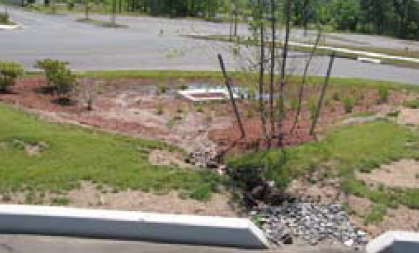
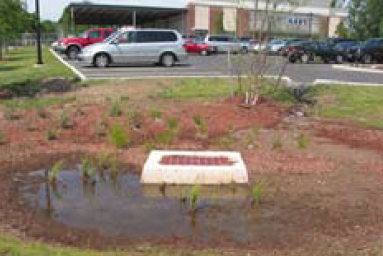
This rain garden is no longer functioning correctly and may not have been properly installed. The inlet has eroded and sediment has clogged the infiltration area. Routine maintenance is essential to repair this type of damage as quickly as possible. Images by National NEMO Network.
Typical Seasonal Maintenance Tasks for a Vegetated LID Practice*
| Year |
Spring |
Summer |
Fall |
Winter |
| 1 |
Install practice, plant vegetation, and install irrigation system (if needed). |
Control weeds and remove sediment, debris and trash as needed. |
Control weeds and remove sediment, debris and trash as needed. |
Inspect for erosion and sedimentation after storm events. Repair as needed. |
| 2-4 |
Inspect structures, embankments, inlets and outlets. Check for signs of erosion and repair as needed. Adjust irrigation system and replace mulch as needed. |
Control weeds and remove sediment, debris and trash as needed. Check for standing water or mosquitoes. |
Control weeds and remove debris and sediment as needed. Check for standing water or mosquitoes. |
Inspect structures, embankments, inlets and outlets. Check for signs of erosion and repair as needed. |
| 5-10 |
As above, plus replace plants as needed. |
As above. |
As above. |
As above. |
*Vegetated LID practices include bioretention systems, vegetated swales and buffers.
Questions to Answer When Developing LID Maintenance Plans:
- WHERE is the facility located?
- WHO is responsible for inspections and maintenance?
- HOW OFTEN should the facility be checked and maintained?
- WHAT maintenance is required?
- HOW DIFFICULT is the maintenance to perform?
- What will it COST?
- WHO is responsible for recordkeeping and reporting?
For a description of various Low Impact Development practices
consult the following Fact Sheets in the “Low Impact Development in Northern Nevada” series:
- LID: An Introduction, FS-09-22
- Soil Considerations, FS-09-23
- Rainwater Harvesting, FS-09-24
- Bioretention, FS-09-25
- Vegetated Swales and Buffers, FS-09-26
- Green Roofs, FS-09-27
- Plant Materials, FS-09-28
- Porous Pavement, FS-09-29
- Roadway and Parking Lot Design, FS-09-30
- Maintenance, FS-09-31
Who is responsible for inspections and maintenance?
While it is tempting to place responsibilities for maintenance on homeowners or homeowners’ associations (HOAs), it is probably not realistic. Homeowners can maintain small, simple facilities such as rain gardens on their properties if they are provided with specific instructions, but generally lack the ability and tools to perform more complex maintenance. Most HOAs lack the training, experience and staff necessary to provide high-quality maintenance. In most cases, some level of responsibility for inspection and maintenance will fall on private contractors or city/county/state jurisdictions.
If homeowners are expected to play a role in inspections and maintenance, they must be provided with sufficient education and appropriate checklists or other materials.
How often should the facility be checked?
Periodic monitoring is inexpensive when compared to the cost of renovating a failed facility. Frequency varies with the type of facility and the design specifications. More frequent inspections will be needed in areas where a lot of upstream erosion and sediment transport is occurring.
All facilities should be monitored a minimum of once a year, as well as following storm events that exceed the capacity of the facility. Any facility that incorporates irrigation should be checked at the beginning of the irrigation season to ensure the system is operating correctly, and periodically during the growing season to adjust irrigation to seasonal plant needs.
How often should the facility be maintained?
Each type of stormwater treatment facility will require maintenance specific to its design. Signs that maintenance of LID practices is needed include the following:
- Water has ponded for longer than 48 to 72 hours after a rainfall event (for infiltration facilities, including porous pavement).
- Insects become a problem.
- Vegetation is overgrown, dead, missing, wilting or damaged.
- Invasive weeds are present.
- Erosion is visible.
- Sediment has accumulated.
- Trash is present.
- Vandalism has occurred, or there has been improper use by the public or animals.
- The mulch layer is too thin.
- The overflow structure is clogged or damaged.
What maintenance is required?
Maintenance needs vary by the type of facility. Some common activities include:
- Vegetation management, such as mowing, pruning, replanting and weed control
- Sediment removal
- Trash removal
- Clearing of curb cuts
- Pest control, including insects and rodents
- Replacement of mulch
- Repair of eroded areas
- Repair or retrofit of irrigation systems
- Unclogging overflow pipes or structures and underdrains
- Sweeping and suction cleaning of porous pavement
Consult the individual fact sheets in this series for more information on the maintenance needs for specific facilities.
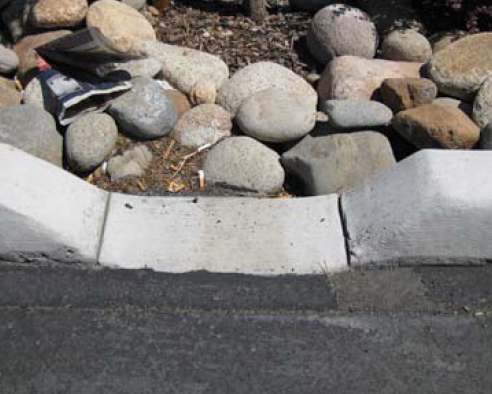
Routine maintenance of this parking lot inlet consists of sediment and trash removal. Image by Melody Hefner.
How difficult is the maintenance to perform?
Complexity can vary widely, but most routine maintenance of LID practices can be performed without special training or equipment. A survey of Minnesota Municipal Public Works Managers found that most maintenance tasks were minimal and simple and rarely required a professional (Kang et al., 2008). Porous pavement was one exception, since routine sweeping and vacuuming with specialized equipment is necessary to prevent sediment from clogging pores.
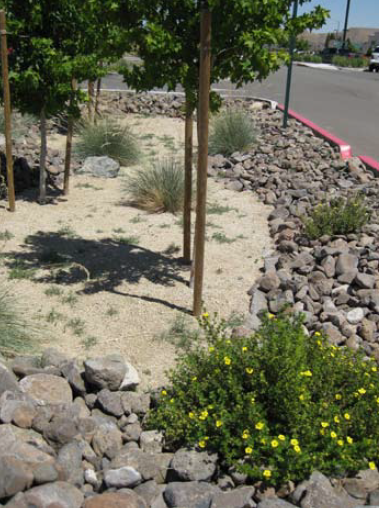
This parking lot island requires some minor maintenance in the form of weed removal. Image by Melody Hefner.
What will it cost?
Costs can be highly variable, and depend upon the specific type of facility, its size, the volume of stormwater and sediment that can be retained in the facility, how easy it is to access the facility for maintenance, and disposal methods for sediment and debris. If available, onsite disposal is typically the most cost-effective.
Use caution when stockpiling removed sediment to ensure it does not wash or blow onto pavement or into storm drains. If loading and hauling are required, maintenance costs will increase significantly.
Some estimates suggest that annual maintenance costs may vary from $100 per acre for routine simple landscape maintenance such as mowing, to $500 or more for debris or sediment removal. (Northern Virginia Regional Commission, 2007). Nonroutine or infrequent maintenance costs should be considered and included in budgets.
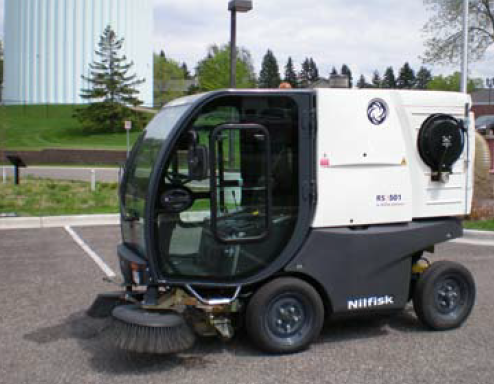
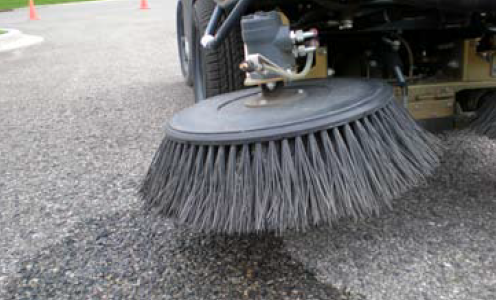
Routine maintenance of porous pavement includes vacuum sweeping at least twice a year. Images by John Bilotta.
Who is responsible for recordkeeping and reporting?
Keeping records helps document ongoing performance of the facility, typical maintenance needs, and routine costs. Records should be submitted by the entity performing the maintenance to whoever has stormwater oversight, such as the local utility company, the county or the homeowner’s association, or via a report provided to the contracting entity by the private maintenance contractor.
For additional detailed planning and design information
Refer to the latest versions of the Truckee Meadows Low Impact Development Handbook and the Truckee Meadows Structural Controls Design Manual available at TMS.
References:
- Kang, J-H, P.T. Weiss, J.S. Gulliver and B.C. Wilson, 2008, Maintenance of Stormwater BMPs, Stormwater Magazine, November/December 2008
- Northern Virginia Regional Commission, 2007, Maintaining Stormwater Systems
Additional information about maintenance of stormwater facilities can be found at:
- Low Impact Development Center, Inc., LIDC
- Maintenance of Low Impact Development Facilities
- Portland, Oregon Stormwater Management Manual, Chapter 3.0, Operations and Maintenance, Revised September 2004
Technical review provided by Chris Conway, Certified Professional in Sediment and Erosion Control.
Donaldson, S.
2009,
Low Impact Development in Northern Nevada: Maintenance,
Extension | University of Nevada, Reno, FS-09-31


